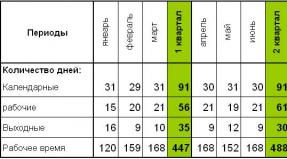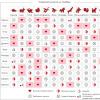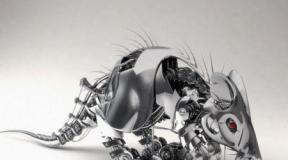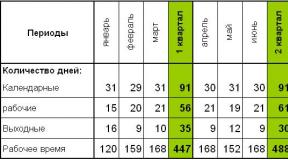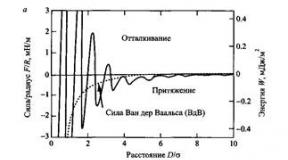A simple gas burner differs from one with a thermostat. Types of gas burners for heating boilers. Proper care is the key to long-term operation
The main elements of a gas burner: a mixer and a burner nozzle with a stabilizing device. Depending on the purpose and operating conditions of the gas burner, its elements have different designs.
In gas diffusion burners, gas and air are supplied to the combustion chamber. The mixing of gas and air occurs in the combustion chamber. Most gas diffusion burners are mounted on the walls of the firebox or furnace. The so-called boilers have become widespread. gas hearth burners, which are placed inside the firebox, in its lower part. A gas hearth burner consists of one or more gas distribution pipes in which holes are drilled. A pipe with holes is installed on a grate or firebox floor in a slotted channel lined with refractory bricks. The required amount of air enters through the fire-resistant slot channel. With this device, the combustion of streams of gas emerging from the holes in the pipe begins in the fire-resistant channel and ends in the combustion volume. Hearth burners create little resistance to the passage of gas, so they can operate without forced air.
Gas diffusion burners are characterized by a more uniform temperature along the length of the torch.
However, these gas burners require an increased excess air ratio (compared to injection ones), and also create lower thermal stresses in the combustion volume and worse conditions for post-burning of gas in the tail part of the torch, which can lead to incomplete combustion of the gas.
Gas diffusion burners are used in industrial furnaces and boilers, where uniform temperature along the length of the torch is required. In some processes, gas diffusion burners are indispensable. For example, in glass melting, open-hearth and other furnaces, when the combustion air is heated to temperatures exceeding the ignition temperature of the combustible gas with air. Gas diffusion burners are also successfully used in some hot water boilers.
In injection burners, combustion air is sucked in (injected) due to the energy of the gas stream and their mutual mixing occurs inside the burner body. Sometimes in gas injection burners the suction of the required amount of combustible gas, the pressure of which is close to atmospheric, is carried out by the energy of a jet of air. In full-mix burners (all the air necessary for combustion is mixed with the gas), operating on medium-pressure gas, a short flame is formed, and combustion is completed in a minimum combustion volume. Partial mixing gas injection burners receive only part (40 ÷ 60%) of the air required for combustion (the so-called primary air), which is mixed with the gas. The remaining amount of air (the so-called secondary air) enters the flame from the atmosphere due to the injection action of gas-air jets and vacuum in the furnaces. Unlike medium-pressure gas injection burners, low-pressure burners produce a homogeneous gas-air mixture with a gas content greater than the upper ignition limit; These gas burners are stable in operation and have a wide range of heat loads.
For stable combustion of the gas-air mixture in medium- and high-pressure gas injection burners, stabilizers are used: additional igniting torches around the main flow (burners with a ring stabilizer), ceramic tunnels inside which combustion of the gas-air mixture occurs, and plate stabilizers that create turbulence in the flow path.
In fireboxes of considerable size, gas injection burners are assembled into blocks of 2 or more burners.
Gas injection burners using infrared radiation (so-called flameless burners) are widely used, in which the main amount of heat generated during combustion is transferred by radiation, because the gas burns on the emitting surface in a thin layer, without a visible flame. The radiating surface is ceramic nozzles or metal mesh. These burners are used for heating rooms with a high air exchange rate (gyms, retail premises, greenhouses, etc.), for drying painted surfaces (fabrics, paper, etc.), heating frozen soil and bulk materials, in industrial ovens. For uniform heating of large surfaces (furnaces of oil refineries and other industrial furnaces), the so-called. panel injection radiant burners. In these burners, the gas-air mixture from the mixer enters a common box, and then the mixture is distributed through tubes into separate tunnels, in which its combustion occurs. Panel burners have small dimensions and a wide control range, and are insensitive to back pressure in the combustion chamber.
The use of gas turbine burners, in which air is supplied by an axial fan driven by a gas turbine, is increasing. These burners were proposed at the beginning of the 20th century (Eykart turbo burner). Under the action of the reactive force of the escaping gas, the turbine, shaft and fan are driven into rotation in the direction opposite to the outflow of gas. The burner performance is regulated by the pressure of the incoming gas. Gas turbine burners can be used in boiler furnaces. High-pressure gas turbine burners with self-supply of air through recuperators and air economizers are promising: high-capacity gas-fuel oil burners operating on heated and cold air.
The following requirements apply to burners:
1. The main types of burners must be mass-produced in factories according to technical specifications. If burners are manufactured according to an individual project, then upon commissioning they must undergo tests to determine the main characteristics;
2. Burners must ensure the passage of a given amount of gas and the completeness of its combustion with a minimum air consumption coefficient α, with the exception of burners for special purposes (for example, for furnaces in which a reducing environment is maintained);
3. When ensuring a given technological regime, the burners must ensure a minimum amount of harmful emissions into the atmosphere;
4. The noise level generated by the burner should not exceed 85 dB when measured with a sound level meter at a distance of 1 m from the burner and at a height of 1.5 m from the floor;
5. Burners must operate stably without flame separation or flashover within the design range of thermal power control;
6. For burners with preliminary complete mixing of gas and air, the flow rate of the gas-air mixture must exceed the speed of flame propagation;
7. To reduce energy consumption for your own needs when using burners with forced air supply, the resistance of the air path should be minimal;
8. To reduce operating costs, the burner design and stabilizing devices must be fairly easy to maintain and convenient for inspection and repair;
9. If it is necessary to preserve reserve fuel, the burners must ensure rapid transfer of the unit from one fuel to another without disturbing the technological regime;
10. Combined gas and oil burners should provide approximately the same quality of combustion of both types of fuel - gas and liquid (fuel oil).
Diffusion burners
In diffusion burners, the air necessary for gas combustion comes from the surrounding space to the front of the torch due to diffusion.
Such burners are usually used in household appliances. They can also be used when increasing gas flow, if it is necessary to distribute the flame over a large surface. In all cases, the gas is supplied to the burner without admixture of primary air and mixed with it outside the burner. Therefore, these burners are sometimes called external mix burners.
The simplest diffusion burners in design (Fig. 7.1) are a pipe with drilled holes. The distance between the holes is selected taking into account the speed of flame propagation from one hole to another. These burners have low thermal output and are used when burning natural and low-calorie gases under small water heating devices.
Rice. 7.1. Diffusion burners:

Fig.7.2. Hearth diffusion burner:
1 – air regulator; 2 – burner; 3 – viewing window; 4 – centering glass; 5 – horizontal tunnel; 6 – brick linings; 7 – grate
Industrial diffusion burners include hearth slot burners (Fig. 7.2). They usually consist of a pipe with a diameter of up to 50 mm, in which holes with a diameter of up to 4 mm are drilled in two rows. The channel is a slot in the bottom of the boiler, hence the name of the burners - hearth slots.
From burner 2, gas exits into the furnace, where air enters from under the grate 7. Gas streams are directed at an angle to the air flow and are evenly distributed over its cross section. The process of mixing gas with air is carried out in a special slot made of refractory bricks. Thanks to this device, the process of mixing gas with air is enhanced and stable ignition of the gas-air mixture is ensured.
The grate is lined with refractory bricks and several slots are left in which pipes with drilled holes for gas outlet are placed. Air is supplied under the grate by a fan or as a result of vacuum in the firebox. The refractory walls of the crack are combustion stabilizers, prevent flame separation and at the same time increase the heat transfer process in the firebox.
Injection burners.
Injection burners are called burners in which the formation of a gas-air mixture occurs due to the energy of a gas stream. The main element of an injection burner is the injector, which sucks air from the surrounding space into the burners.
Depending on the amount of injected air, burners can be completely pre-mixed with gas or air or with incomplete air injection.
Burners with partial air injection . Only part of the air necessary for combustion enters the combustion front; the rest of the air comes from the surrounding space. Such burners operate at low gas pressure. They are called low pressure injection burners.
The main parts of injection burners (Fig. 7.3) are the primary air regulator, nozzle, mixer and manifold.
The primary air regulator 7 is a rotating disk or washer and regulates the amount of primary air entering the burner. Nozzle 1 serves to convert the potential energy of gas pressure into kinetic energy, i.e. to give the gas stream such a speed that ensures the suction of the necessary air. The burner mixer consists of three parts: injector, confuser and diffuser. Injector 2 creates a vacuum and air leaks. The narrowest part of the mixer is confuser 3, which levels the stream of the gas-air mixture. In diffuser 4, final mixing of the gas-air mixture occurs and its pressure increases due to a decrease in speed.
From the diffuser, the gas-air mixture enters the manifold 5, which distributes the gas-air mixture among the holes 6. The shape of the manifold and the location of the holes depend on the type of burners and their purpose.
Low-pressure injection burners have a number of positive qualities, due to which they are widely used in household gas appliances, as well as in gas appliances for catering establishments and other household gas consumers. Burners are also used in cast iron heating boilers.

Rice. 7.3. Injection atmospheric gas burners:
A– low pressure; b– burner for a cast iron boiler; 1 – nozzle. 2 – injector, 3 – confuser, 4 – diffuser, 5 – manifold. 6 – holes, 7 – primary air regulator
The main advantages of low-pressure injection burners: simplicity of design, stable operation of burners when loads change; reliability and ease of maintenance; quiet operation; possibility of complete combustion of gas and operation at low gas pressures; lack of pressurized air supply.
An important characteristic of incomplete mixing injection burners is the injection coefficient - the ratio of the volume of injected air to the volume of air required for complete combustion of the gas. So, if for complete combustion of 1 m 3 of gas, 10 m 3 of air is required, and the primary air is 4 m 3, then the injection coefficient is 4:10 = 0.4.
A characteristic of burners is also the injection ratio - the ratio of primary air to burner gas flow. In this case, when 4 m3 of air is injected per 1 m3 of burned gas, the injection ratio is 4.
The advantage of injection burners: their self-regulating property, i.e. maintaining a constant proportion between the amount of gas supplied to the burner and the amount of injected air at a constant gas pressure.
Mixing burners. Burners with forced air supply.
Burners with forced air supply are widely used in various thermal devices of municipal and industrial enterprises.
According to the principle of operation, these burners are divided into burners with preliminary mixing of gas (Fig. 7.4) and fuel and burners without preliminary preparation of the gas-air mixture. Burners of both types can operate on natural, coke, blast furnace, mixed and other combustible gases of low and medium pressure. Operating regulation range - 0.1 ÷ 5000 m 3 /h.
Air is supplied to the burners by centrifugal or axial fans of low and medium pressure. Fans can be installed on each burner or one fan per group of burners. In this case, as a rule, all the primary air is supplied by fans, while the secondary air has practically no effect on the quality of combustion and is determined only by air leaks into the combustion chamber through leaks in the combustion fittings and hatches.
The advantages of burners with forced air supply are: the possibility of use in combustion chambers with different back pressure, a significant range of regulation of thermal power and gas-air ratio, relatively small torch sizes, low noise during operation, simplicity of design, the possibility of preheating gas or air and using burners large unit power.
Low pressure burners are used at a gas flow rate of 50 ÷ 100 m 3 /h; at a flow rate of 100 ÷ 5000, it is advisable to use medium pressure burners.
The air pressure, depending on the design of the burner and the required thermal power, is assumed to be 0.5 ÷ 5 kPa.
To better mix the fuel-air mixture, gas is supplied to most burners in small jets at different angles to the flow of primary blast air. In order to intensify mixture formation, the air flow is given turbulent movement using specially installed swirl blades, tangential guides, etc.
The most common burners with forced air supply of internal mixing include burners with a gas flow rate of up to 5000 m3/h or more. They can provide a predetermined quality of preparation of the fuel-air mixture before it is fed into the combustion chamber.
Depending on the design of the burner, the processes of mixing fuel and air can be different: the first is the preparation of the fuel-air mixture directly in the mixing chamber of the burner, when the finished gas-air mixture enters the firebox, the second is when the mixing process begins in the burner and ends in the combustion chamber. In all cases, the flow rate of the gas-air mixture is different: 16...60 m/s. Intensification of the mixture formation of gas and air is achieved by jet gas supply, the use of adjustable blades, tangential air supply, etc. When jet gas supply, burners with a central gas supply (from the center of the burner to the periphery) and with a peripheral gas supply are used.
The maximum air pressure at the burner inlet is 5 kPa. It can operate with back pressure and vacuum in the combustion chamber. In these burners, unlike external mixing burners, the flame is less luminous and relatively small in size. Ceramic tunnels are most often used as stabilizers. However, all the methods discussed above can be used.
A GNP type burner with forced air supply and central gas supply, designed by specialists from the Teploproekt Institute, is intended for use in combustion devices with significant thermal stresses. These burners provide for swirling of the air flow using blades. The burner kit includes two nozzles: a type A nozzle, used for short-flame gas combustion with 4-6 gas outlet holes directed perpendicularly or at an angle of 45° to the air flow, and a type B nozzle, used to produce an elongated torch and having one central hole directed parallel to the air flow. In the latter case, the preliminary mixing of gas and air occurs much worse, which leads to an elongation of the torch.
Stabilization of the torch is ensured by the use of a fire-resistant tunnel made of fireclay bricks of class A. The burners can operate in cold and heated air. Excess air coefficient - 1.05. Burners of this type are used in steam boilers and the baking industry.
The GMG two-wire gas and oil burner is designed for burning natural gas or low-sulfur liquid fuels such as diesel, household, naval fuel oil F5, F12, etc. Co-combustion of gas and liquid fuel is allowed.
The gas nozzle of the burner has two rows of holes directed at an angle of 90° to each other. The holes on the side surface of the nozzle allow gas to be supplied into the swirling flow of secondary blast air, and the holes on the end surface - into the swirling flow of primary air.
The process of formation of a gas-air mixture in burners with forced air supply begins directly in the burner itself, and ends in the furnace. During the combustion process, the gas burns with a short and dull flame. The air required for gas combustion is forced into the burner using a fan. Gas and air are supplied through separate pipes.
This type of burner is also called two-wire or mixing burner. The most commonly used are burners operating at low gas and air pressure. Also, some burner designs are used at medium pressure.
Burners are installed in boiler furnaces, heating and drying furnaces, etc.
Operating principle of a forced air burner:
Gas enters nozzle 1 with a pressure of up to 1,200 Pa and leaves it through eight holes with a diameter of 4.5 mm. These holes should be located at an angle of 30° to the burner axis. Special blades, which set the rotational movement of the air flow, are located in the burner body 2. During operation, gas in the form of small streams enters a swirling air stream, which helps to ensure good mixing. The burner ends with a ceramic tunnel 4 having a pilot hole 5.

Rice. 7.4. Forced air burner:
1 - nozzle; 2 - body; 3 - front plate; 4 – ceramic tunnel.
Burners with forced air supply have a number of advantages:
-high performance;
– wide range of performance control;
– possibility of working in heated air.
In the existing various burner designs, intensification of the process of formation of the gas-air mixture is achieved in the following ways:
– splitting gas and air flows into small flows in which mixture formation takes place;
– supplying gas in the form of small streams at an angle to the air flow;
– by twisting the air flow with various devices built into the burners.
Combination burners.
Combination burners are those that operate simultaneously or separately on gas and fuel oil or on gas and coal dust.
They are used in case of interruptions in the gas supply, when it is urgently necessary to find another type of fuel, when gas fuel does not provide the required temperature regime of the furnace; Gas is supplied to this facility only at a certain time (at night) to level out the daily unevenness of gas consumption.
Gas-oil burners with forced air supply are most widely used. The burner consists of gas, air and liquid parts. The gas part is a hollow ring with a fitting for gas supply and eight tubes for gas spraying.
The liquid part of the burner consists of an oil head and an inner tube ending with nozzle 1 (Fig. 7.5).
The supply of fuel oil to the burner is controlled by a valve. The air part of the burner consists of a body, a swirler 3, an air damper 5, with which you can regulate the air supply. The swirler serves to better mix the fuel oil stream with air. Air pressure is 2÷3 kPa, gas pressure is up to 50 kPa, and fuel oil pressure is up to 0.1 MPa.

Rice. 7.5. Combined oil and gas burner:
1 – fuel oil nozzle, 2 – air chamber, 3 – swirler, 4 – gas outlet tubes, 5 – air control valve.
The use of combined burners gives a higher effect than the simultaneous use of gas burners and oil nozzles or gas pulverized coal burners.
Combination burners are necessary for reliable and uninterrupted operation of gas-using equipment and installations of large industrial enterprises, power plants and other consumers for which interruption in operation is unacceptable.
Let's consider the principle of operation of a combined dust and gas burner designed by Mosenergo (Fig. 7.6)
When operating on coal dust, a mixture of primary air and coal dust is supplied to the furnace through the annular channel 3 of the central pipe, and secondary air enters the furnace through volute 1.
Fuel oil serves as a backup fuel; in this case, a fuel oil nozzle is installed in the central pipe. When converting the burner to gas fuel, the fuel oil nozzle is replaced with a ring channel through which gas fuel is supplied.
A pipe with a cast iron tip 2 is installed in the central part of the channel. The tip has 2 oblique slits through which the gas exits and intersects with the flow of swirling air emerging from the volute 1. In improved burner designs, instead of slits, the tip has 115 holes with a diameter of 7 mm. As a result, the gas exit speed almost doubles (150 m/s).

Rice. 7.6. Combined dust and gas burner with central gas supply:
1 – volute for twisting the air flow, 2 – tip of the gas supply pipes,
3 – annular channel for supplying a mixture of primary air with coal dust.
New burner designs use peripheral gas supply, in which gas jets, which have a higher speed than air jets, cross a swirling air flow moving at a speed of 30 m/s at a right angle. This interaction of gas and air flows ensures rapid and complete mixing, as a result of which the gas-air mixture burns with minimal losses.
7.3. Automation of gas combustion processes.
The properties of gas fuel and modern designs of gas burners create favorable conditions for the automation of gas combustion processes. Automatic control of the combustion process increases the reliability and safety of operation of gas-using units and ensures their operation in accordance with the most optimal mode.
Today, partial or complex automation systems are used in gas-fired installations.
Complex gas automation consists of the following main systems:
– automatic control;
– automatic safety;
– alarm system;
– teletechnical control.
Regulation and control of the combustion process is determined by the operation of gas appliances and units in a given mode and ensuring optimal gas combustion mode. For this purpose, regulation of the combustion process is intended for automatic regulation of household, municipal and industrial gas appliances and units. Thus, a constant temperature of the water in the tank is maintained for capacitive water heaters, and a constant steam pressure for steam boilers.
The gas supply to the burners of gas-using installations is stopped by the safety automatics in the event of:
– extinguishing of the torch in the firebox;
– decreasing air pressure in front of the burners;
– increased steam pressure in the boiler;
– increasing the water temperature in the boiler;
– reducing the vacuum in the furnace.
Disabling these settings is accompanied by corresponding sound and light signals. No less important is the control of gas pollution in the room in which all gas appliances and units are located. For these purposes, electromagnetic valves are installed that stop the gas supply in cases where the maximum permissible concentration in the ambient air CH 4 and CO 2 is exceeded.
It is possible to achieve optimal conditions under technological process conditions using thermal control devices
The operating conditions of gas-using equipment determine the degree of its automation.
Remote control of gas-using installations is achieved through the use of control and alarm devices.
Single-stage, two-stage and modulating burners for heating boilers. Review.
When choosing burners, consumers face a difficult task– which burner to choose . This choice allows them to make a small comparison of burners from different manufacturers by type of regulation and level of automation of the burner device.
We invite you to familiarize yourself with the opinion of our company’s specialists, based on the experience of using combined, liquid fuel and gas burners from Weishaupt, Elco, Cib Unigas and Baltur.
Let's determine the basic requirements for burners, depending on the application. Depending on the area of application, burners can be divided into groups.
Group 1. Burners for individual heating systems (in this group we include burners with a power of up to 500 - 600 kW, which are installed in boiler rooms of private houses, small industrial and commercial and administrative buildings).
When choosing burners for this group of consumers, it is necessary to take into account the buyer’s wishes in the level of automation of an individual boiler room:
· if you do not have high technical requirements for the installed equipment and want to have a reliable boiler room that does not require large initial financial investments, then you can opt for burners with single-stage, two-stage operating modes;
· if as a result you want to build a heating system with a high level of automation, weather-dependent regulation, as well as low fuel and energy consumption, then it is better for you to use modulating burners or burners with smooth two-stage regulation, which will provide the ability to program power and a wide operating range of burner control.
Group 2. Burners for heating systems of large residential complexes (in this group we include burners with a capacity of more than 600 kW for the needs of housing and communal services, central heating, as well as for heat supply of large industrial and commercial and administrative buildings).
· Smooth two-stage or modulating burners are ideal for this group. This is due to: the high power of boiler houses, the customer’s desire to build a boiler house with a high level of automation, the desire to ensure the lowest possible fuel and electricity consumption (use frequency control of fan power), and also use equipment for automatic control of residual oxygen in flue gases (oxygen control).
Group 3. Burners for use on process equipment (this group can include burners of any power, depending on the power of the process equipment).
· Preferred for this group modulating burners. The choice of these burners is determined not so much by the wishes of the customer, but by the technological requirements of production. For example: in some production processes it is necessary to maintain a strictly defined temperature schedule and prevent temperature changes, otherwise this can lead to disruption of the technological process, product damage and, as a result, significant financial losses. Burners with step control can also be used in process plants, but only in cases where minor temperature fluctuations are acceptable and do not entail negative consequences.
Brief description of the operating principle of burners with different types of regulation.
Single stage burners They operate only in one power range, they operate in a mode that is difficult for the boiler. When single-stage burners operate, frequent switching on and off of the burner occurs, which is controlled by the automatic control of the boiler unit.
Two stage burners , as the name suggests, have two power levels. The first stage typically provides 40% of the power, and the second 100%. The transition from the first stage to the second occurs depending on the controlled boiler parameter (coolant temperature or steam pressure), the on/off modes depend on the boiler automation.
Smooth two-stage burners allow for a smooth transition from the first stage to the second. This is a cross between a two-stage and modulating burner.
Modulating burners heat the boiler continuously, increasing or decreasing power as necessary. The range of combustion mode changes is from 10 to 100% of the rated power.
Modulating burners are divided into three types according to the operating principle of modulating devices:
1. burners with a mechanical modulation system;
2. burners with pneumatic modulation system;
3. burners with electronic modulation.
Unlike burners with mechanical and pneumatic modulation, burners with electronic modulation allow for the highest possible control accuracy, since mechanical errors in the operation of burner devices are eliminated.
Price advantages and disadvantages
Of course, modulating burners are more expensive than stepped models, but they have a number of advantages over them. The mechanism for smooth power control allows you to reduce the cycle of turning on and off boilers to a minimum, which significantly reduces mechanical stress on the walls and components of the boiler, and therefore prolongs its “life”. Fuel savings are at least 5%, and with proper tuning you can achieve 15% or more. And finally, installing modulating burners does not require replacing expensive boilers if they are functioning properly, while increasing the efficiency of the boiler.
Against the background of the disadvantages of stepped burners, the advantages of modulating burners are obvious. The only factor forcing managers to choose step models is their lower price. But savings of this kind are deceptive: wouldn’t it be better to spend a large sum at a time on more advanced, economical and environmentally friendly burners? Moreover, the costs will pay off in the next few years!
Many buyers understand the benefits of using modulating burners, and now they only have to choose the necessary models. Which manufacturers are best to contact? Even with a superficial study of prices for imported and domestic burners, it is clear that the difference is quite significant. Some models from foreign manufacturers are more than twice as expensive as Russian-made products.
A detailed analysis of the market for burner manufacturers shows that Russian equipment is significantly inferior to imported analogues in terms of automation level. In order to achieve a high level of automation of Russian-made burners, it is necessary to invest quite a bit of money on the acquisition of the necessary automation systems and installation and commissioning of equipment. Based on the results of all the work, it turns out that the cost of retrofitted Russian-made burners is close to the cost of imported burners. But at the same time, you will not have a 100% guarantee that a fully equipped Russian burner will provide you with the desired result.
Conclusion of our experts
Choosing the right burner is an important step in the construction or modernization of a boiler room. The further operation of the heating equipment depends on how responsibly you approach this issue. Stable operation of the burner, compliance with environmental standards, longer service life of boilers and the ability to fully automate the operation of a thermal power plant indicate significant advantages of using modulating burners in boiler houses. And if the benefit from their operation is obvious, not taking advantage of it is simply unreasonable.
Burners Weishaupt / Germany Elco/ Germany , Cib Unigas / Italy, Baltur / Italy have proven themselves to be reliable and high-quality equipment. By choosing these burners, you get confidence and profit! In turn, we are ready to provide you with reasonable prices and the shortest delivery time for equipment.
Selecting a burner correctly is an important step in the construction or repair of a boiler room. The further operation of the heating equipment depends on how responsibly the managers and organizers approached this issue.
Modernization of the heating sector is the most important task facing managers of housing and communal services. Choosing a partner for the design, supply, installation and commissioning of equipment is not a problem, but the question of the efficiency of operation of boiler houses after their conversion remains open. A limited budget forces you to find the simplest solutions - purchase cheap, short-lived equipment that requires constant attention. But now there are fully automated systems, for the selection and maintenance of which it is best to contact highly qualified specialists who have a complete understanding of how a modern boiler room should function.
When choosing burners, consumers are faced with a difficult task: what to give preference to - domestic or foreign equipment. And here sellers of imported burners often use a cunning trick: they compare smooth two-stage burners of foreign production with modulated burners of domestic production. Even with a significant difference in prices for “similar” products, they insist on German, Finnish, Italian quality, trying to persuade buyers to purchase these particular burners. However, any specialist working with boiler equipment understands that it is at least incorrect to compare different types of burners only based on the price component. Therefore, it is necessary to know the difference between their technical characteristics and capabilities.
The most widespread in boiler houses are two-stage, smoothly two-stage and modulating burners. Two-stage burners, as the name suggests, have two power levels. The first stage provides 40% of the power, and the second - 100%. The transition from the first stage to the second occurs depending on the controlled boiler parameter (direct water temperature or steam pressure), the on/off modes depend on the boiler automation.

Smooth two-stage burners allow a smooth transition from one stage to the second. This is a cross between a two-stage and modulating burner. Modulating burners heat the boiler continuously, increasing or decreasing power as needed. The range of combustion mode changes is from 10 to 100% of the rated power.
Of course, modulating burners are more expensive than stepped models, but they have a number of advantages over them. The mechanism for smooth power control allows you to reduce the cycle of turning on and off boilers to a minimum, which significantly reduces mechanical stress on the walls and components of the boiler, and therefore prolongs its “life”. Fuel savings are at least 5%, and with proper tuning you can achieve 15% or more. And finally, installing modulating burners does not require replacing expensive boilers if they are functioning properly. When operating stepped burners, the boiler experiences significant loads, which eventually destroy the unit.

Against the background of the disadvantages of stepped burners, the advantages of modulating burners are obvious. The only factor forcing managers to choose step models is their lower price. But savings of this kind are deceptive: wouldn’t it be better to spend a large sum at a time on more advanced, economical and environmentally friendly burners, especially since these costs will pay off in the next few years?
Smart managers understand the benefits of using modulating burners, and now all they have to do is select the necessary models. Which manufacturers are best to contact? Even with a superficial study of prices for imported and domestic burners, it is clear that the difference is quite significant. Some models from foreign manufacturers are more than twice as expensive as Russian-made products. And yet, stereotypes that quality goods come only from abroad force people to pay more. However, a more detailed analysis of the market for burner manufacturers shows that we also have high-quality competitive products. For more than 15 years, the Starorussian Instrument-Making Plant has been producing various models of burners that are successfully installed on all types of domestic and imported boilers. Modulating block burners from this manufacturer comply with all environmental standards for fuel combustion, have a wide range of power control (from 10 to 100%), while ensuring maximum efficiency. When looking for reliable, economical burners for boiler rooms, it’s simply impossible not to pay attention to them. Simple installation of equipment already produces tangible results, and if experienced burner adjustment specialists are involved in the process, fuel savings can amount to more than 15%. With the use of modulating burners from Staroruspribor, managers will be able to temporarily forget about another cost item - replacing the boiler. Switching to a “gentle” operating mode allows you to double its service life. Those who know how expensive such equipment is (prices are calculated in millions of rubles) will appreciate the possibility of replacing these units more rarely.
Selecting a burner correctly is an important step in the construction or renovation of a modernized boiler room. The further operation of the heating equipment depends on how responsibly the customers approach this issue. If, for example, you use modulating burners produced by JSC Staroruspribor Plant, then after two or three heating seasons the costs will more than pay off. Stable operation, compliance with environmental standards, longer service life of boilers and the ability to fully automate the operation of a thermal power plant indicate significant advantages of using modulating burners in boiler houses. And if the benefit from their operation is obvious, not taking advantage of it is simply unreasonable.
Related links
Comments
Adding a new comment
In a country house or a full-fledged private one, if you do not live in it all year round or there are no central heating pipes nearby to connect the building to them, then installing a compact gas heater is a suitable option. It will come in handy in the cold season from time to time. Yes, and in the summer there is cool weather. for a summer house it will be useful when you need to dry the room. It is too labor-intensive to start building a full-fledged heating circuit if the house is small. A gas heater powered by a cylinder and easily moved from place to place is much better suited for such conditions. More often, units running on natural gas are purchased as a portable heat source.
The basic equipment of the average includes a housing, burner, heat exchanger, heating element and gas cylinder. In addition, the heater is equipped with a thermostat and an automated mechanism for shutting off the gas supply.
Buyers choose gas heaters for their low price, compactness, clear operating principle and good efficiency. The following types of gas heaters exist:
- Gas catalytic heater
- Infrared device
Heating devices are divided into outdoor and indoor devices.
Gas Italian convector for a summer residence
This type of heater resembles a standard battery; it is also placed under the window opening. Gas convectors running on natural gas use both gas from the gas pipeline and the liquefied version as fuel. The gas burns in an insulated container, heating the air that separates the chamber from the body of the device. The convector heats a small room in a matter of minutes, which is convenient if you visit a country house in cool weather and there is a need to quickly warm up the room. The convector independently maintains the required temperature regime. When the desired heating temperature is reached, combustion becomes less intense. If the fire goes out, the protective system is activated and the device turns off.
Catalytic gas heater
This type of device is powered by gas or gasoline. With its help you can heat a room of any size: from a small hut to a large warehouse. Heat is generated through the process of catalytic combustion. It is distinguished by the absence of flames and any sounds, but at the same time the active release of a large amount of heat. Heat is released due to the oxidation of fuel trapped on the surface of the panel. The catalyst included in the surface material provokes oxidation. All processes occur on the solid surface of the panel, without flowing into gaseous forms.
Such devices are safe, not subject to spontaneous combustion, and do not pollute the environment.The heating element of the catalytic heater is a catalytic panel made of fiberglass with the addition of platinum. At the moment, instead of platinum, more relevant catalysts are used, which promote deep oxidation and not. Some models are equipped with a fan heater to increase power. A gas heater can quickly heat the air in a room.
In terms of their characteristics, catalytic devices are close to infrared heating devices. They are inferior to them in the speed of heating the room, but they are silent.
Infrared model with thermostat and ceramic burner: from a cylinder and a line
Infrared or powered by a gas pipeline. Models with an infrared ceramic gas burner differ from other infrared devices by the presence of an open flame during operation. Such devices serve for a long time and heat efficiently, evenly filling the entire room with heat in a short time. Despite such attractive characteristics, gas ceramic heaters are not the most popular. The reason is the high price. But the burner is worth it: it is independent of electricity, does not dry out the air in the room, and is easy to install.
The infrared device is suitable for heating large-scale premises: hangars, hypermarkets. There is a wide range of devices on the market with different configurations and mountings. It is not difficult to choose an infrared ceramic gas heater that will fit perfectly into the interior and will meet all technical requirements. This heater can be installed on the floor, wall or ceiling.
Radiation arising on the surface of the heating element. If other heaters for a summer residence warm up the air itself, then infrared equipment heats objects in the room, which then give off heat to the room itself.
At the dacha, an infrared heating device is doubly convenient: it can be used not only at home, but also placed in a gazebo to heat it in cool weather.
Most outdoor heaters used in cafes or bus stops are infraredOutdoor gas heater Foreman: an inexpensive option
An outdoor heater is indispensable for those who like to spend a lot of time outdoors, have picnics, and grill kebabs over an open fire. With such a device, you can not deny yourself the pleasure of being outside even in very cool weather, and extend the summer season. In appearance, the outdoor gas heater resembles a street lighting pole. The fuel is located in a tank located at the base of the structure. It is filled with gas as needed.
Outdoor heat sources are used not only in summer cottages, but also on the summer verandas of cafes and children's play areas in the fresh air.
In addition to full-fledged outdoor heating devices, there is a portable gas heater. The most common compact devices are the kovea brand. A small-sized gas heater is ideal for a tent to keep warm while fishing or hunting. This company also produces other products for tourism, for example, such as an infrared burner for cooking in camping conditions.
Stove on a gas cylinder: Chinese and other options
A gas stove for a summer cottage with a cylinder is a good alternative to a classic brick stove. According to the principle of operation, such a device resembles a gas boiler. The design of the stove includes: a burner with a firebox, a heating panel and the body itself.
There may be several reasons to install gas stoves in your dacha:
- It quickly warms up the room
- No need to clean the chimney pipes, unlike a brick stove
- Temperature can be adjusted
- Easy to move to another location if necessary
- Safe to use
- Does not require electricity
Models are heat-intensive and non-heat-intensive. Heat-intensive ones accumulate heat in themselves, cooling more slowly.
Rules for choosing the best heater: price and quality
The main thing when choosing a heater is to correctly calculate the required power. Traditionally, when determining this parameter, a standard flow rate is used: 1 kW per 10 sq. m. It is better to add a little more to the number obtained when calculating in reserve. To cover heat loss that will involuntarily occur during operation of the heater.
Direct or indirect heating. It depends on the type of heating whether the device will take air directly from the room and release products arising during combustion into it, or whether the unit involves the removal of combustion products. Direct heating requires ventilation. They are not recommended for use in enclosed spaces.
It is important to make sure that it is possible to conveniently connect the heater to the network. If the unit operates on cylinders, then cylinders are purchased with it and their compatibility with the device is checked.
Additional features. The presence of a thermostat and an emergency gas supply shut-off mechanism is something worth keeping in mind when purchasing. Some devices operate with multiple fuel options. The protective algorithm takes into account several factors independently of each other: tilt of the device, flame level, interruption of fuel supply.
WATCH THE VIDEO
Gas dachas are an excellent way to heat a room.
Gas heating of industrial and residential premises occurs under automatic control. Today's technologies make it possible to carry out precise regulation desired temperature, while saving on fuel. This result was achieved through the use of burners with a power control option, which is ensured by the automatic operation of the gas burner.
An automatic gas burner for a boiler is a device that mixes gas with air and burns this resulting composition in a combustion chamber.
How does the automatic temperature control system work?
The simplest system of automatic control of a set temperature using a gas burner works like this: gas is supplied to the burner, which is ignited by the ignition function, and thus constant combustion occurs. At the same time, the burner itself operates at full power. When a certain temperature of the coolant or air in the room is reached, the automatic gas burner extinguishes the fire.
To maintain the set temperature, the burner is constantly turned on and off.
Classification of gas burners by temperature control
With modern developments in technology, new, improved methods of automatic temperature control have been developed:
- Single-stage burners are the simplest devices, the operating principle of which was described above. These burners operate in the same mode.
- Two-stage burners are devices that can operate in two states (40% and 100% of total power), switching between themselves automatically.
- Smooth two-stage burners - these also operate in two states (40% and 100%), but the switching between modes occurs more smoothly, which significantly saves fuel itself and improves the quality of temperature support.
- Modulating gas burners with boiler automation are the most functional devices, capable of operating in a wide power range (from 10 to 100%). They can maintain a temperature regime with a deviation of only 20C from the initial value. At the same time, the efficiency of fuel combustion increases and the temperature loads on the parts of the heating device decrease.
The most effective among all is the copper heat exchanger, as it has thin walls and good thermal conductivity. BUT it does not tolerate high temperature voltages, therefore it has a short service life. In combination with a modulated automatic gas burner, its service life increases.
Gas burners with the option to change the combustion level are expensive, but their efficiency quickly pays for all costs:
— the temperature is maintained in a small range;
— fuel savings up to 30%;
— the service life of the entire device is increased.
So we recommend buying a gas burner with automatic control!
Basic elements of an auto control system
Devices included in the burner electrical circuit to initiate automatic operation of the device:
— Relay is maximum. and minimum gas pressure - has a light structure, which affects its long service life. The principle of operation is that the gas pressure affects the membrane, and when it deviates from the set mode, the system is activated and the control valve carries out the required work. Relay min. gas pressure protects against a decrease in gas pressure to a critical point, and the maximum pressure switch makes adjustments, preventing an increase in the permissible value.
— Minimum and maximum coolant pressure relay — protects the heating system from excessive decrease and increase in pressure of the heating device. Both options are dangerous and undesirable for the continued operation of the boiler, therefore, when the critical point (lower or upper) is reached, the boiler turns off, that is, the gas supply stops.
— The combustion controller is a part that combines the operation of the entire burner into a common process. The operation of gas burners in heating boilers with automation is divided into several sections, which correspond to the required position of the fuel control valve and air damper. Having received a signal about a low temperature, the controller opens the appropriate mechanisms to increase the combustion force. The controller operates based on signals from various sensors (temperature, pressure).
— The thermostat is a signaling device for reaching temperature limits. Based on its signal, the combustion modes are changed.
— Boiler filling sensor — necessary to protect the burner from turning on without the presence of coolant in the boiler.

The connection of sensors largely depends on the boiler manufacturer. This data can be seen in the device passport, and the features of connecting sensors are carefully described in additional instructions. In this case, the connection and configuration of the automatic system must be checked by a gas service employee. In his presence, commissioning work is also carried out, with the obligatory drawing up of a report on the serviceability of the equipment for safe operation.
Types of auto control systems for gas boilers
There are control systems of different brands and purposes, but they all work on the same principles. They differ only in the functionality of the system and dependence on the electrical network.
All varieties can be combined into three main groups of gas burner automation:
- Non-volatile types.
- Energy-dependent wire systems.
- Volatile wireless.
The non-volatile boiler control structure is the most basic automation for a heating device. Its operating principle is based on the physical law of expansion when the material is heated. A similar effect of this law can be observed in the example of a thermometer - mercury, when heated, expands and rises upward along a tube attached to the scale. The reverse process is visible when cooling.
Now imagine that the same design stands inside the boiler and measures the temperature of the heated device, only instead of mercury they use another material (metal). It expands when heated and affects the mechanical lever that stops the gas supply. As soon as the burner cools down, the metal contracts, acting on the lever, and the gas supply is resumed.
The energy-dependent boiler control system operates from the electrical network - which creates inconvenience, but at the same time increases the productivity of the equipment. The main part of such systems is the thermostat. Depending on the temperature conditions, it supplies an electromagnetic pulse to the gas valve. But with the help of a special program, it is possible to program the temperature regime for several days in advance, weeks or even months.

The non-volatile wireless boiler control system operates on the same principle as a wired one. The only difference is that the control module of the wireless version is located in any place convenient for you, and it is not connected by wire to the device.
Some devices provide for the installation of a GSM module that provides access through mobile gadgets (smartphones, tablets). To find out the latest data on the device’s status, you just need to go to the application on your smartphone and enter the required password.
Through mobile devices it is possible not only to control gas burners with automatic heating boilers, but also to control them. And if a special situation arises, the system will automatically send you a notification in the form of SMS to your number.
Today, modern technologies can provide full automatic control over an autonomous heating system without creating additional effort.
